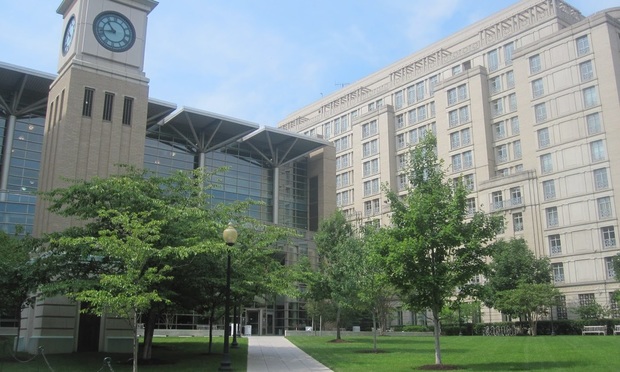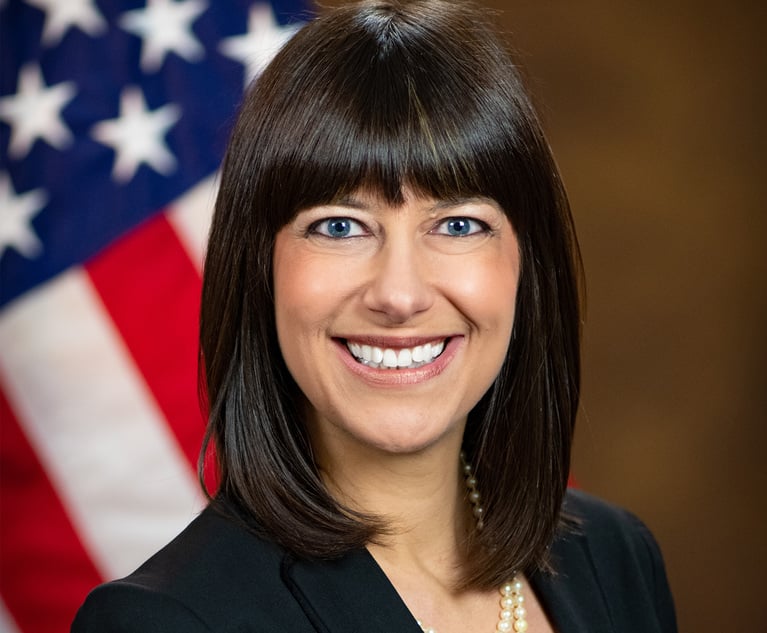DC Law Schools See Students Increasingly Attracted to Big Law Jobs
More than 40 percent of Georgetown Law's graduates last year joined one of the country's 100 largest firms in terms of head count after graduation.
March 29, 2018 at 01:45 PM
5 minute read
 Georgetown University
Georgetown University
Top law schools in the nation's capital say they are seeing an uptick in students' interest in careers outside of government and public interest, particularly in Big Law and at corporations typically aimed at business graduates.
More than 40 percent of Georgetown Law's graduates last year joined one of the country's 100 largest firms in terms of head count after graduation, according to ALM data—and the school thinks that percentage could rise.
“We're seeing our numbers climb in our interest in large law firms in Big Law,” said Marcia Pennington Shannon, Georgetown Law's assistant dean for career strategy. “We do put a big emphasis on [Big Law careers] because we know it's something that our students want.”
Georgetown Law sent more than 270 graduates to the 100 largest law firms last year.
Twenty of the school's 2017 graduates joined Latham & Watkins, according to ALM data. More Georgetown Law students went to Latham & Watkins than went to any of the other top 100 firms. The National Law Journal measured the 100 largest law firms by lawyer head count as compiled via The National Law Journal's annual survey.
Latham & Watkins, which last year became the first firm to exceed $3 billion in annual revenue, took more students from Georgetown than from any other law school last year, ALM data show. Harvard Law School served as a close second to Georgetown on the Los Angeles-based Latham's list of top feeder schools in 2017.
“Latham's been very involved here, so our students are seeing them and engaging with them,” Shannon said.
Shannon said Georgetown students engage with large law firms soon after arriving on campus, via its walk-around programs and receptions for first-year law students. The walk-around programs offer Georgetown students the opportunity to meet with leading firms in their D.C. offices, which are already stocked with Hoya alumni.
Shannon said students talk more about connecting on a personal level with firm lawyers as a result of the students' walk-around program and other events than previous Georgetown Law students did a decade ago.
She said Georgetown Law has also witnessed firms increasingly making personal approaches to its students, who Shannon said appear more interested in the firms' culture than their predecessors.
And over in DC's Foggy Bottom neighborhood, many George Washington University Law School students similarly appear to have their eye on Big Law firms.
ALM data show nearly 18 percent of last year's graduates from GW Law went to one of the nation's 100 largest firms, and GW said about a third of its students are interested in pursuing careers in Big Law.
Katherine White, GW Law director of employment outreach, said via email that most GW students who enter Big Law utilize the school's on-campus interview program. She said “almost all” of the Am Law 100 firms with summer associate programs participate in the on-campus interview program that results in second-year students landing summer associate positions.
While public interest law practices and government have historically grown their ranks with GW Law graduates, many students at George Washington are beginning to look elsewhere.
“One trend we have noticed over the last several years is that a growing number of students are pursuing careers with employers that have historically recruited students from MBA programs, such as consulting firms, financial institutions and corporations,” White said.
Of the 108 GW Law graduates entering the top 100 law firms last year, ALM data show Kirkland & Ellis; Paul, Weiss, Rifkind, Wharton & Garrison and Wilmer Cutler Pickering Hale and Dorr as the top magnets.
Howard University School of Law, which is based in the Van Ness neighborhood and counts U.S. Supreme Court Justice Thurgood Marshall among its alumni, sent just under 20 percent of last year's graduating class to the largest 100 law firms. Howard University Law's assistant dean of career services Neil Dennis said via email the numbers of its second- and third-year law students heading toward Big Law firms are “looking even better” with a greater percentage of students going into corporate or large law firm settings in the coming summer and fall.
While a much smaller number and percentage of George Mason University's students pursued careers in Big Law than other area-schools on the list, the Antonin Scalia Law School across in nearby Northern Virginia cracked Law.com's Go-To Law Schools' list for the first time.
George Mason sent 8.55 percent of its graduating class to the 100 largest law firms last year, according to data compiled by ALM. Suzanne Mund, Antonin Scalia Law School director of career services, said she has witnessed an increase in Big Law firms overtures to students on campus and an uptick in the student's interest in Big Law.
The Antonin Scalia Law School at George Mason is relatively young—the result of a 1979 merger with the International School of Law in Washington, D.C., created a few years prior—and Mund said more firms are being exposed to students at events on campus.
The school's first attempt at memorializing the late U.S. Supreme Court justice's name in 2016, creating the Antonin Scalia School of Law, produced the ignominious acronym “ASSLaw,” and drew smirks from the Internet. The State Council of Higher Education for Virginia later approved George Mason's requested name change to the Antonin Scalia Law School.
Mund said the Scalia name's cache has translated into the ability to provide academic research and support that has resulted in a longer look at students from Big Law firms.
This content has been archived. It is available through our partners, LexisNexis® and Bloomberg Law.
To view this content, please continue to their sites.
Not a Lexis Subscriber?
Subscribe Now
Not a Bloomberg Law Subscriber?
Subscribe Now
NOT FOR REPRINT
© 2025 ALM Global, LLC, All Rights Reserved. Request academic re-use from www.copyright.com. All other uses, submit a request to [email protected]. For more information visit Asset & Logo Licensing.
You Might Like
View All

So You Want to Be a Tech Lawyer? Consider Product Counseling

Coalition of AGs Support Updates to ABA's Legal Education Diversity Standard
3 minute read
Biden's Top Supreme Court Lawyer Talks Argument Prep, Emergency Docket Ahead of New Term
Trending Stories
- 1Cleary Nabs Public Company Advisory Practice Head From Orrick in San Francisco
- 2New York Environmental Legislation in 2024
- 3Cravath Hires Paul Weiss Antitrust Co-Chair
- 4Contract Technology Provider LegalOn Launches AI-powered Playbook Tool
- 5Court of Appeals Provides Comfort to Land Use Litigants Through the Relation Back Doctrine
Who Got The Work
J. Brugh Lower of Gibbons has entered an appearance for industrial equipment supplier Devco Corporation in a pending trademark infringement lawsuit. The suit, accusing the defendant of selling knock-off Graco products, was filed Dec. 18 in New Jersey District Court by Rivkin Radler on behalf of Graco Inc. and Graco Minnesota. The case, assigned to U.S. District Judge Zahid N. Quraishi, is 3:24-cv-11294, Graco Inc. et al v. Devco Corporation.
Who Got The Work
Rebecca Maller-Stein and Kent A. Yalowitz of Arnold & Porter Kaye Scholer have entered their appearances for Hanaco Venture Capital and its executives, Lior Prosor and David Frankel, in a pending securities lawsuit. The action, filed on Dec. 24 in New York Southern District Court by Zell, Aron & Co. on behalf of Goldeneye Advisors, accuses the defendants of negligently and fraudulently managing the plaintiff's $1 million investment. The case, assigned to U.S. District Judge Vernon S. Broderick, is 1:24-cv-09918, Goldeneye Advisors, LLC v. Hanaco Venture Capital, Ltd. et al.
Who Got The Work
Attorneys from A&O Shearman has stepped in as defense counsel for Toronto-Dominion Bank and other defendants in a pending securities class action. The suit, filed Dec. 11 in New York Southern District Court by Bleichmar Fonti & Auld, accuses the defendants of concealing the bank's 'pervasive' deficiencies in regards to its compliance with the Bank Secrecy Act and the quality of its anti-money laundering controls. The case, assigned to U.S. District Judge Arun Subramanian, is 1:24-cv-09445, Gonzalez v. The Toronto-Dominion Bank et al.
Who Got The Work
Crown Castle International, a Pennsylvania company providing shared communications infrastructure, has turned to Luke D. Wolf of Gordon Rees Scully Mansukhani to fend off a pending breach-of-contract lawsuit. The court action, filed Nov. 25 in Michigan Eastern District Court by Hooper Hathaway PC on behalf of The Town Residences LLC, accuses Crown Castle of failing to transfer approximately $30,000 in utility payments from T-Mobile in breach of a roof-top lease and assignment agreement. The case, assigned to U.S. District Judge Susan K. Declercq, is 2:24-cv-13131, The Town Residences LLC v. T-Mobile US, Inc. et al.
Who Got The Work
Wilfred P. Coronato and Daniel M. Schwartz of McCarter & English have stepped in as defense counsel to Electrolux Home Products Inc. in a pending product liability lawsuit. The court action, filed Nov. 26 in New York Eastern District Court by Poulos Lopiccolo PC and Nagel Rice LLP on behalf of David Stern, alleges that the defendant's refrigerators’ drawers and shelving repeatedly break and fall apart within months after purchase. The case, assigned to U.S. District Judge Joan M. Azrack, is 2:24-cv-08204, Stern v. Electrolux Home Products, Inc.
Featured Firms
Law Offices of Gary Martin Hays & Associates, P.C.
(470) 294-1674
Law Offices of Mark E. Salomone
(857) 444-6468
Smith & Hassler
(713) 739-1250










